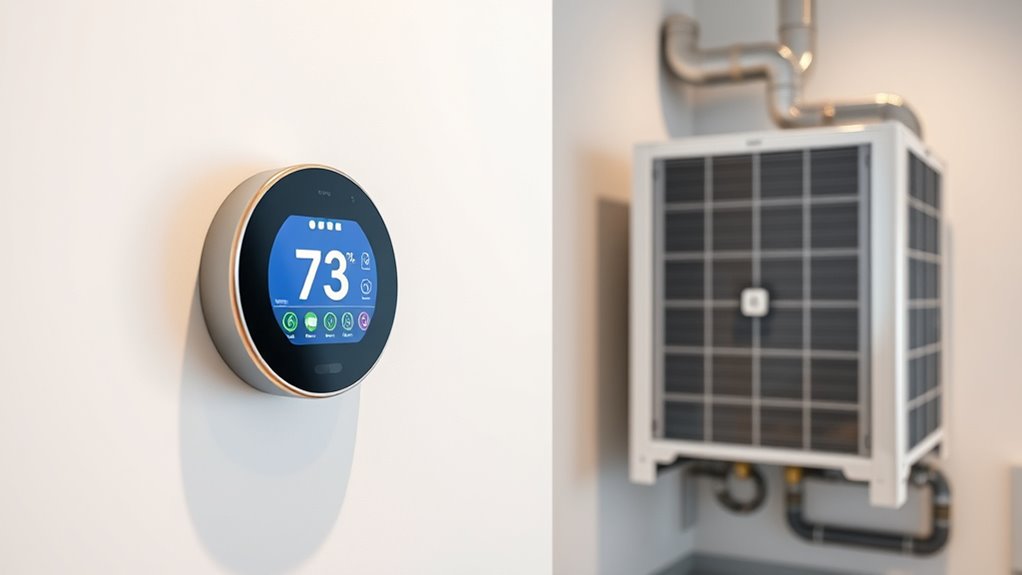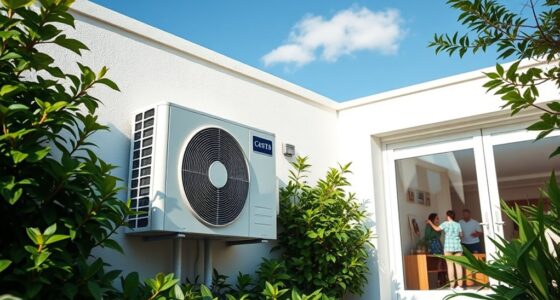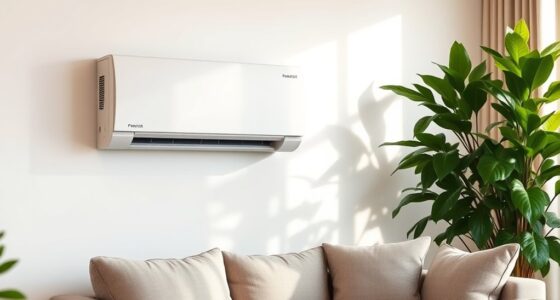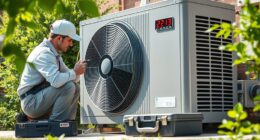Smart thermostats work with heat pumps by precisely controlling components like reversing valves and auxiliary heat, helping you manage indoor temperatures efficiently. They support multi-stage systems, offer remote control, scheduling, and advanced features like sensors and geofencing. Proper installation and compatibility are key to maximizing benefits like energy savings and comfort. If you’re curious about optimizing your heat pump system, you’ll find plenty of useful tips and insights ahead.
Key Takeaways
- Smart thermostats precisely control heat pump functions, including reversing valves and auxiliary heating, for optimized indoor climate management.
- Compatibility requires support for multi-stage systems, proper wiring, and features like remote sensors and auxiliary heat control.
- Advanced features such as adaptive learning, geofencing, and zone control enhance energy efficiency and user comfort.
- Proper installation involves verifying system compatibility, correct wiring, and strategic placement away from heat sources or drafts.
- Future trends include AI-driven optimization, enhanced sensors, and seamless integration via protocols like Matter for smarter energy management.
Understanding How Smart Thermostats Work With Heat Pumps
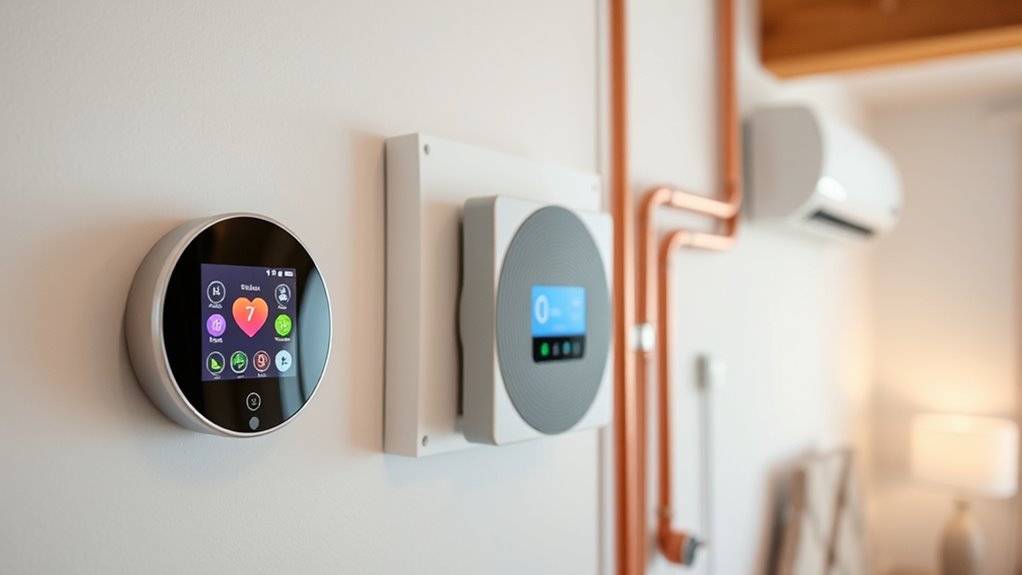
Smart thermostats designed for heat pumps work by precisely controlling the system’s multiple components, such as reversing valves and auxiliary heating. These heat pump thermostats are built for system compatibility, ensuring they work seamlessly with two-stage or multi-stage heat pump systems. They manage temperature regulation by adjusting indoor settings and activating auxiliary heat when needed, maintaining comfort efficiently. Many models support specialized wiring, like the C-wire or adapters, to connect properly with heat pump systems. Advanced algorithms optimize performance by balancing outdoor and indoor temperatures, reducing energy waste. Additionally, integration with smart home platforms allows you to control your heat pump remotely, set schedules, and use geofencing. Proper placement and system compatibility are key to accurate temperature detection and system longevity. Proper installation is essential to ensure the thermostat functions correctly and maximizes efficiency. Understanding industry trends can help in selecting the most compatible and efficient smart thermostat for your heat pump system. Incorporating cybersecurity best practices when connecting smart devices can further protect your home network from potential vulnerabilities. Furthermore, advancements in AI technology are enabling smarter, more adaptive control systems that can learn user habits over time. Regular system maintenance and system diagnostics can also enhance the longevity and efficiency of your heat pump setup.
Key Features to Consider When Choosing a Thermostat for Heat Pumps
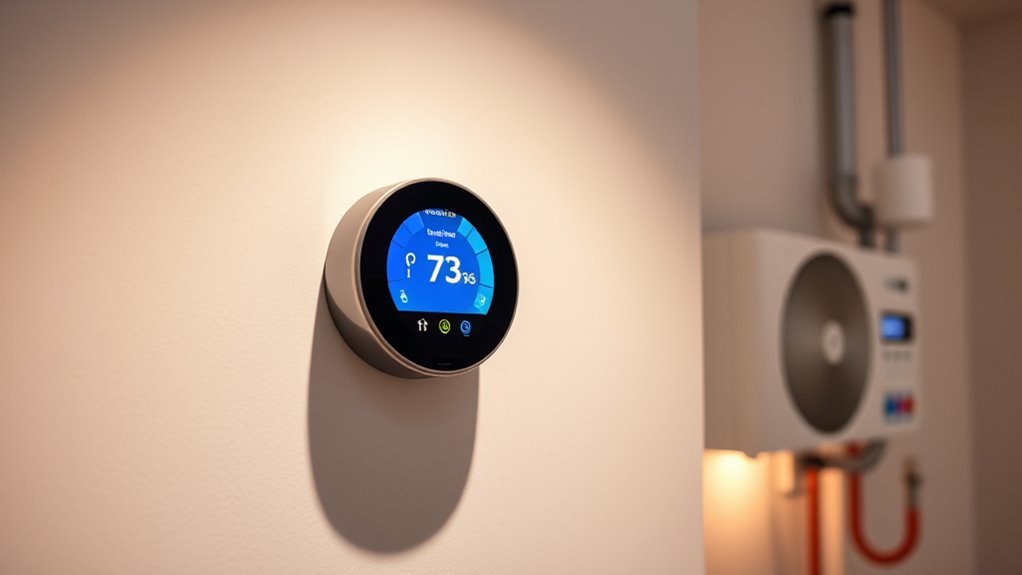
When choosing a thermostat for your heat pump, it’s vital to concentrate on features that guarantee compatibility and ideal performance. Look for heat pump control options that include reversing valve management and auxiliary heat control to ensure smooth operation. Multi-stage thermostats are essential, as they can efficiently handle different heat pump capacities, providing better temperature regulation. Additionally, prioritize models with energy-saving features like smart automation, sensors, and modes that reduce energy consumption without sacrificing comfort. Verify that the thermostat matches your system’s wiring requirements, especially if it needs a C-wire or alternative power source. Proper system compatibility with your electrical components ensures long-term functionality and reduces the risk of failure. A thorough understanding of system compatibility can help prevent costly mismatches and installation issues. Incorporating prophetic dream symbolism understanding can also help identify patterns that might optimize system performance over time. Considering industry standards and certifications can further guarantee the reliability and safety of your thermostat choice. Recognizing the importance of essential features can lead to more effective climate control and energy efficiency. By focusing on these key features, you can optimize your heat pump’s performance, enhance efficiency, and enjoy smarter, more reliable climate control.
Compatibility Tips: Ensuring Your Heat Pump and Thermostat Work Together
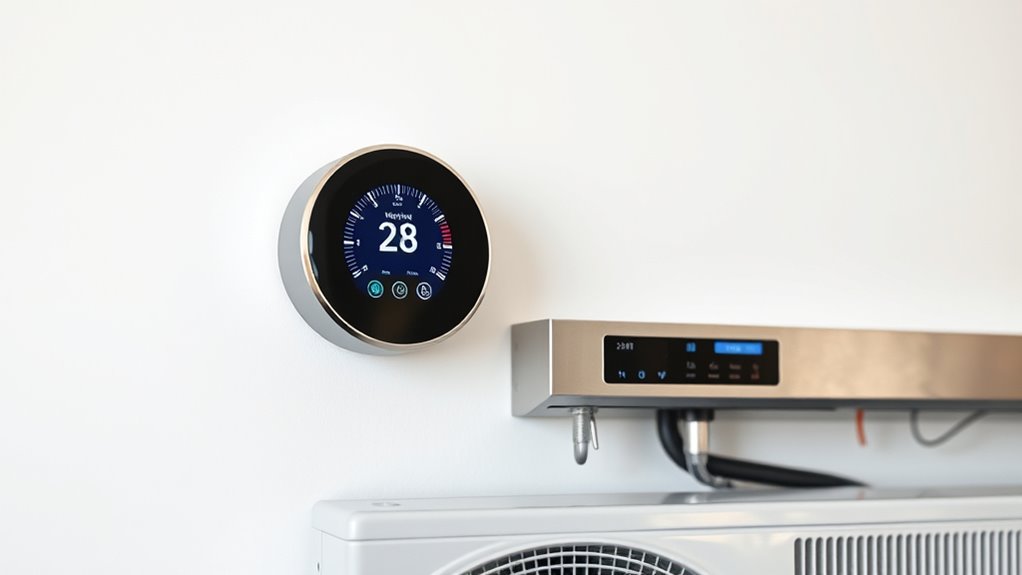
Making certain your heat pump and thermostat are compatible is crucial for peak performance and energy efficiency. To do this, check that your thermostat supports dual-stage operation and reversing valve control, essential for effective heating and cooling. Make sure the thermostat is designed specifically for heat pump systems, as standard thermostats often lack features like auxiliary heat control or defrost functions. Verify if the thermostat supports a C-wire or has a power adapter, which is often necessary for stable operation. Additionally, choose thermostats with built-in or compatible remote sensors to monitor multiple zones accurately. Proper system compatibility may also require understanding cost and budgeting, especially when dealing with different brands or models. Understanding the value of home security systems can inform your decision-making process to ensure you select a reliable and cost-effective setup. Incorporating energy efficiency features into your selection process can further optimize your system’s performance and reduce long-term costs. Considering the compatibility with existing HVAC components can help prevent future upgrades or replacements. Finally, confirm that the thermostat can be configured for your heat pump type—whether single-stage, multi-stage, or variable-speed—to ensure ideal compatibility.
Installing a Smart Thermostat on a Heat Pump System: What You Need to Know
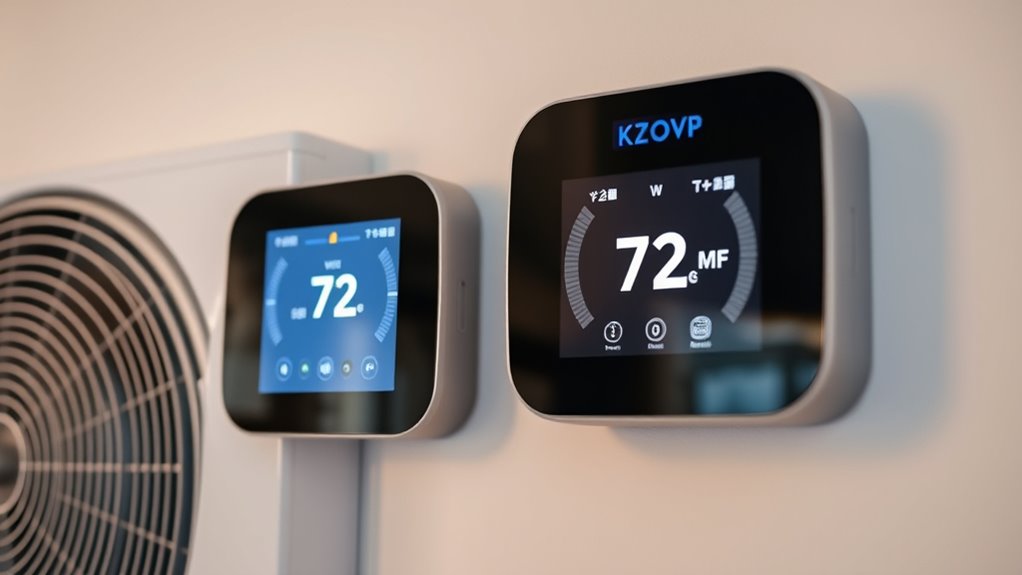
Installing a smart thermostat on a heat pump system involves several important steps to guarantee compatibility and ideal performance. First, verify that your heat pump and smart thermostat are compatible, especially for dual-stage or multi-zone systems. Many heat pump thermostats require a C-wire for reliable operation; if you lack one, consider using an adapter or alternative wiring. Proper placement is key—install the thermostat on an interior wall away from direct sunlight, drafts, or heat sources to ensure accurate readings. When selecting a smart thermostat, prioritize features like reversing valve control, auxiliary heat support, and multi-stage compatibility. Additionally, understanding the Vetted options available can help you choose a reliable device suited to your heat pump system.
The Benefits of Using Smart Thermostats With Heat Pumps
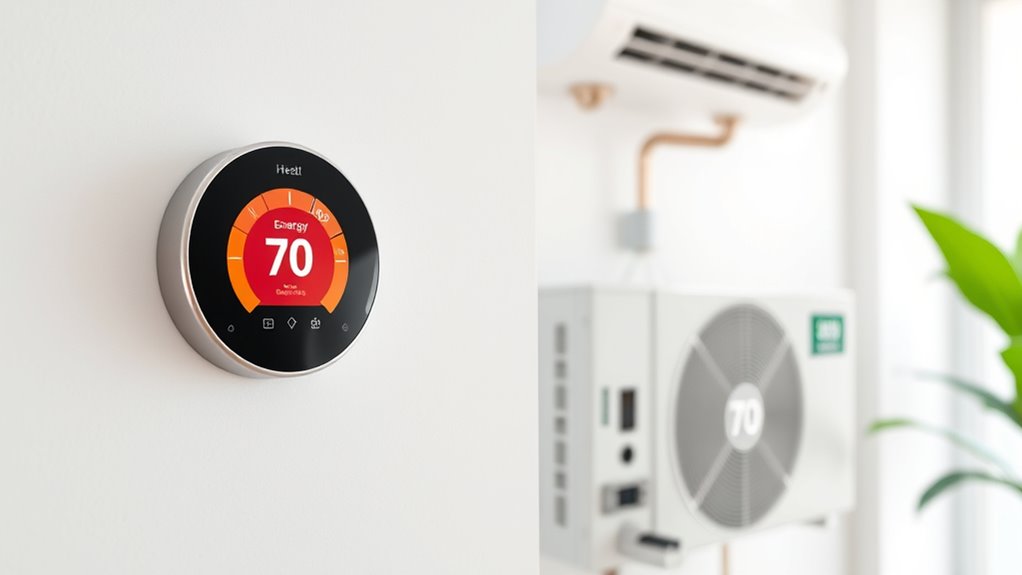
Using a smart thermostat with your heat pump can substantially boost energy efficiency, saving you money on utility bills. It offers precise temperature control, ensuring your home stays comfortable without wasting energy. Plus, you can manage your system remotely, giving you convenience and better system oversight wherever you are. Implementing performance cookies can help monitor and optimize how effectively your system operates. Additionally, integrating smart thermostats with home automation systems can further enhance overall energy management and convenience. Being aware of potential security vulnerabilities is also crucial to protecting your smart home setup from unauthorized access. Proper integration with efficient heating technologies ensures maximum eco-friendly benefits and system performance, especially when combined with real-time monitoring features to track energy consumption.
Enhanced Energy Efficiency
Smart thermostats substantially boost the energy efficiency of heat pumps by precisely adjusting temperatures based on real-time data and user behavior. This results in significant energy savings and lower utility bills. With features like adaptive learning, your thermostat learns your schedule, optimizing operation without manual input. Zone control allows you to manage temperatures across different areas, preventing unnecessary heating or cooling. Additionally, geofencing detects your presence, ensuring the heat pump runs only when needed. Real-time energy monitoring helps you identify patterns and make adjustments. Compatibility with smart home platforms further automates this process. Overall, these features work together to maximize heat pump efficiency, reduce waste, and deliver consistent comfort while minimizing energy consumption.
Precise Temperature Control
Smart thermostats equipped with heat pump compatibility deliver highly accurate temperature control, ensuring your indoor climate remains consistent and comfortable. They fine-tune your heat pump systems, preventing temperature swings and maintaining your preferred settings. With features like AI learning and adaptive scheduling, these thermostats optimize heat pump operation, reducing overshoot and energy waste. Remote sensors allow for targeted temperature control across different zones, so each area gets the right amount of heating or cooling. Geofencing technology activates the system only when you’re home, saving energy. Additionally, real-time energy monitoring and detailed reports help you adjust settings for maximum efficiency and lower utility bills. Incorporating home automation systems can further enhance your overall energy management and convenience. Smart thermostat features such as learning algorithms and adaptive controls contribute to more efficient heat pump operation. Enhanced security measures protect sensitive data from cyber threats, ensuring your smart home ecosystem remains secure. A well-integrated system can also improve overall energy efficiency, reducing your environmental impact and lowering costs. Furthermore, understanding the temperature regulation capabilities of these devices helps in fine-tuning their performance for optimal comfort and savings.
Remote System Management
Managing your heat pump system remotely through a smart thermostat offers unmatched convenience and control. With remote management, you can adjust settings from anywhere using your smartphone, ensuring comfort and efficiency. Here are key benefits:
- Receive real-time system alerts to catch issues early and prevent failures.
- Use automatic scheduling, geofencing, and AI-driven optimization to maximize energy savings.
- Support for multi-stage heat pump operation ensures precise temperature regulation.
- Real-time adjustments help reduce energy consumption by up to 30%, lowering utility bills.
- Understanding system components like thermostats and heat pumps can help you troubleshoot issues more effectively.
- Additionally, remote management can help monitor noise levels, ensuring your heat pump operates quietly and within acceptable limits, which is especially important for maintaining a peaceful home environment.
This remote system management not only enhances comfort but also extends your heat pump’s lifespan. By staying connected, you can optimize system performance, improve safety, and enjoy significant energy savings effortlessly.
Best Smart Thermostats for Heat Pump Systems in 2025
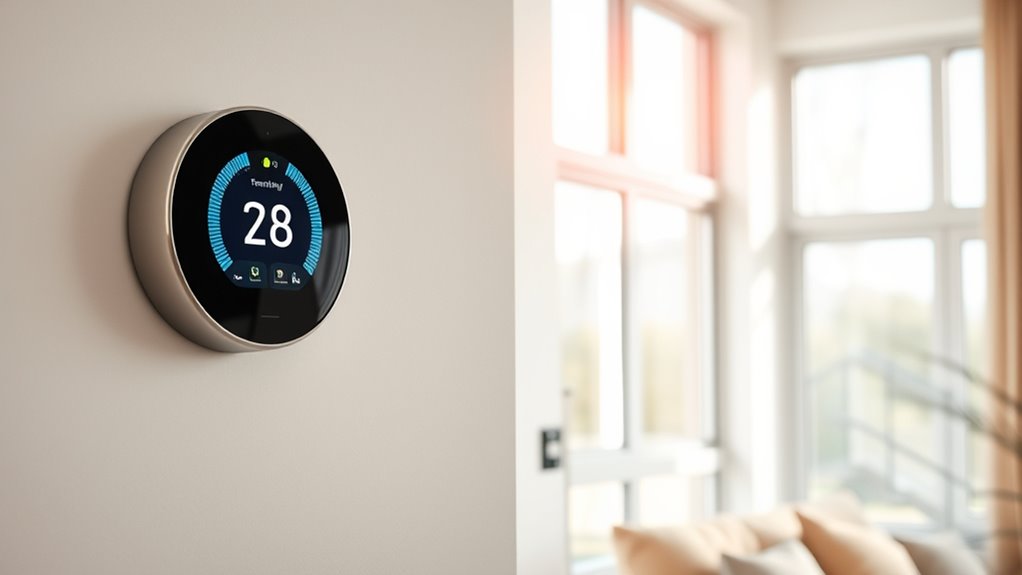
Are you searching for the best smart thermostats to optimize your heat pump system in 2025? The Ecobee Smart Thermostat Premium and Nest Learning Thermostat top the list, thanks to their AI-driven controls, compatibility with smart home platforms, and support for multi-stage heat pump systems. Proper placement on interior walls away from drafts guarantees accurate temperature readings, maximizing efficiency. These thermostats support features like dual-stage control, reversing valve, and emergency heat, which are essential for heat pump operation. Their ability to integrate with voice assistants offers seamless remote management. Here’s a quick comparison:
| Feature | Ecobee Smart Thermostat Premium | Nest Learning Thermostat |
|---|---|---|
| AI & Multi-stage Control | Yes | Yes |
| Compatibility | Smart home ecosystems | Smart home ecosystems |
| Emergency Heat Support | Yes | Yes |
| Voice Assistant Integration | Yes | Yes |
| Placement Tips | Interior wall, away from drafts | Interior wall, away from drafts |
Smart Control and Automation for Heat Pumps: Enhancing Efficiency and Comfort

Smart control and automation let you optimize your heat pump’s performance effortlessly, adjusting settings based on your schedule and preferences. With remote sensors and monitoring, you can keep an eye on energy use and make sure every zone stays comfortable. These strategies help you save energy while maintaining a cozy home environment.
Automated Climate Adjustments
Automated climate adjustments through smart thermostats considerably enhance the efficiency and comfort of heat pump systems. These devices learn your preferences and make real-time decisions to optimize indoor temperatures. With AI-driven scheduling, your heat pump operates at the best times, reducing energy waste and extending equipment lifespan. Geofencing capabilities turn heating on or off based on your proximity, saving energy when you’re away. Integration with smart home platforms allows seamless control via voice or app, adding convenience. Additionally, these thermostats monitor real-time data to adjust auxiliary heat or cooling stages dynamically, ensuring comfort even during weather fluctuations. By leveraging automated climate adjustments, you get a smarter, more efficient, and responsive heating system tailored to your lifestyle.
Remote Monitoring Capabilities
Remote monitoring capabilities allow you to control and optimize your heat pump from anywhere using smartphone apps, providing convenience and flexibility. With a WiFi Thermostat, you can adjust settings remotely, ensuring comfort even when you’re away. Integration with remote sensors in different rooms helps balance temperature distribution, improving efficiency. Features like geofencing automatically modify temperatures based on your location, saving energy. You can also use voice assistants for hands-free control, making adjustments effortless. Automated scheduling and learning algorithms further enhance performance by adapting to your habits. This seamless remote control experience ensures your heat pump operates efficiently, responds quickly to your needs, and maintains comfort without manual intervention.
| Feature | Benefit |
|---|---|
| Remote sensors | Improved temperature balance |
| WiFi Thermostat | Easy remote adjustments |
| Geofencing | Energy savings without effort |
| Voice assistant integration | Hands-free control and automation |
Energy Efficiency Strategies
By leveraging AI, learning algorithms, and geofencing, heat pumps can automatically adjust their operation to maximize energy savings and maintain comfort. This smart control enhances energy efficiency through features like automated scheduling, which optimizes heating and cooling times. Additionally, occupancy detection allows your system to respond dynamically, reducing waste when spaces are unoccupied. Here are four key strategies:
- Implement automated scheduling to pre-heat or cool based on your routines.
- Use occupancy detection to turn off or lessen system activity when rooms are empty.
- Integrate weather data for adaptive adjustments that improve efficiency.
- Analyze energy usage patterns with data insights to identify and target areas for conservation.
These strategies work together to make your heat pump smarter, more efficient, and aligned with your comfort needs.
Common Challenges and Troubleshooting When Integrating Thermostats With Heat Pumps
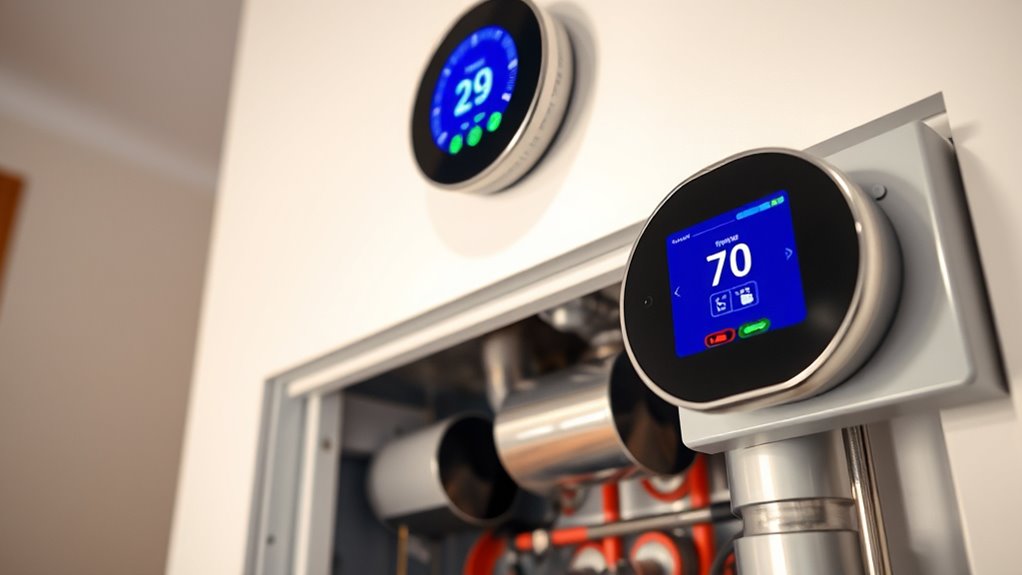
Integrating smart thermostats with heat pumps can present several common challenges that may disrupt your system’s performance. Compatibility issues can prevent the thermostat from working properly or limit functionality. Proper wiring, especially ensuring a reliable C-wire, is vital for stable communication and avoiding malfunctions. Incorrect sensor placement or calibration can lead to inaccurate temperature readings, causing inefficient cycling. Firmware glitches or outdated software may also interfere with system operation, requiring updates or resets. Finally, misconfiguring multi-stage or auxiliary heat settings can cause delays or energy waste.
| Issue | Solution |
|---|---|
| Compatibility problems | Check compatibility before installation |
| Wiring issues | Ensure proper wiring, especially the C-wire |
| Calibration errors | Regularly calibrate sensors for accuracy |
Advanced Features: Sensors, Geofencing, and AI Optimization for Heat Pumps
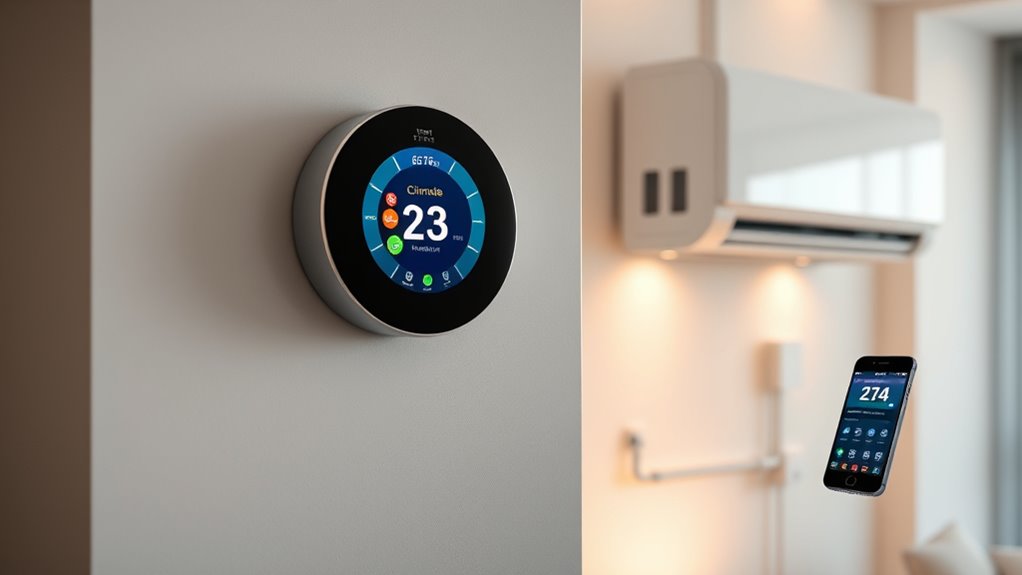
Modern smart thermostats use sensors to detect occupancy and movement, helping your heat pump run more efficiently. Geofencing adjusts temperature settings based on your phone’s location, saving energy when you’re away. AI algorithms analyze data to optimize climate control, ensuring comfort and savings without you having to think about it.
Motion and Occupancy Sensors
Advanced motion and occupancy sensors in smart thermostats actively detect when rooms are occupied, allowing heat pump control to automatically adjust for comfort and efficiency. These sensors use occupancy detection to turn heating or cooling on or off based on presence, saving energy without sacrificing comfort. Here’s how they work:
- Motion sensors identify movement, triggering immediate temperature adjustments.
- Occupancy detection confirms whether a room is in use.
- Sensors communicate with the heat pump to optimize operation across zones.
- Combined with AI, they analyze patterns to refine schedules and improve energy savings.
Location-Based Temperature Control
Building on occupancy detection, location-based temperature control uses sensors, geofencing, and AI to optimize how your heat pump responds to your presence and habits. Occupancy sensors detect activity and temperature changes across zones, while geofencing automatically adjusts settings based on your smartphone’s location, reducing waste. AI algorithms analyze occupancy patterns and weather forecasts to preemptively fine-tune your heat pump for comfort and savings. This dynamic system ensures energy-efficient heating and cooling tailored to your routines.
| Feature | Function |
|---|---|
| Geofencing | Adjusts settings based on smartphone location |
| Occupancy Sensors | Detects activity and temperature variations |
| AI Algorithms | Optimizes operation by analyzing habits and weather |
AI-Driven Climate Optimization
AI-driven climate optimization leverages sophisticated machine learning algorithms to automatically adjust your heat pump’s operation based on real-time data from sensors, occupancy patterns, and weather forecasts. This intelligent control ensures your home stays comfortable while minimizing energy use. Here are some ways it works:
- Sensors detect presence, temperature fluctuations, and air quality, providing immediate data for fine-tuning settings.
- Geofencing activates or deactivates heating or cooling when you enter or leave a predefined zone, reducing unnecessary energy consumption.
- AI algorithms consider humidity, outdoor weather forecasts, and usage history to schedule ideal heat pump cycles.
- Predictive maintenance alerts enhance system performance and longevity, ensuring consistent comfort and efficiency.
This AI-driven climate system delivers precise temperature optimization tailored to your lifestyle.
Future Trends in Smart Thermostats and Heat Pump Technology
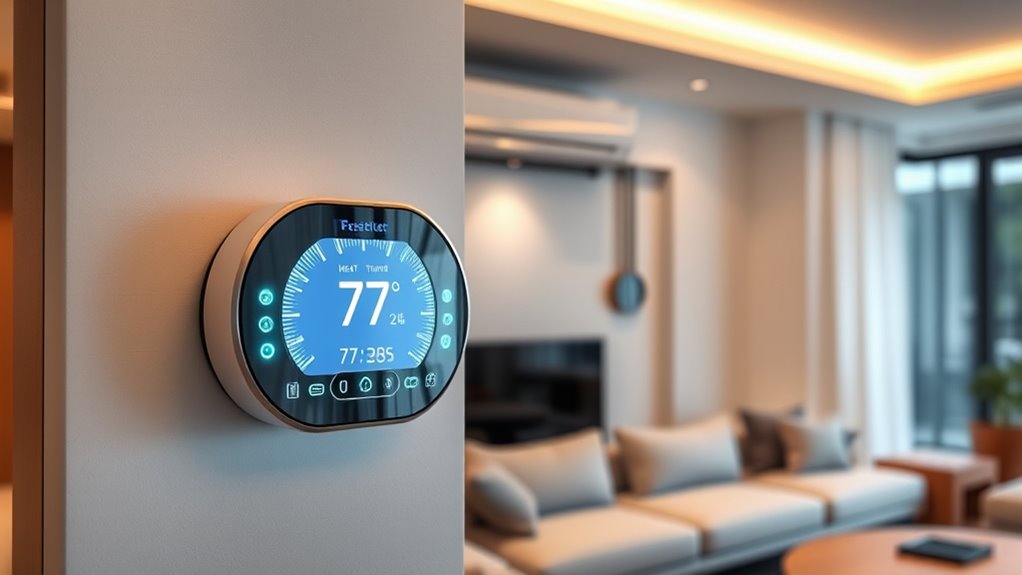
As smart thermostats continue to evolve, their integration with heat pump systems is becoming more sophisticated and seamless. Future models will leverage advanced communication protocols like Matter for effortless heat pump integration, enabling smooth multi-platform control and automation. AI-driven algorithms will optimize heat pump performance by adjusting settings based on real-time weather forecasts, occupancy patterns, and energy prices, boosting efficiency and comfort. Enhanced sensors and machine learning will allow you to precisely balance indoor temperature and humidity, improving overall system performance. The shift toward wireless, plug-and-play configurations will make installation and maintenance simpler, expanding accessibility for homeowners. Industry forecasts suggest that by 2025, nearly 70% of heat pump systems will feature smart thermostats capable of full automation, energy management, and integration with other home systems.
Frequently Asked Questions
Do Nest Thermostats Work Well With Heat Pumps?
You might wonder if Nest thermostats work well with heat pumps. They generally do, offering good control over your system, including managing auxiliary heat and reversing valves. However, verify your wiring matches Nest requirements and that your system supports the features. Proper installation and setup are key to getting the best performance, so double-check compatibility and consider professional help if needed for ideal operation.
Is There a Downside to Smart Thermostats?
They say, “Every coin has two sides,” and smart thermostats are no exception. You might face compatibility issues with certain heat pumps, and internet outages could cut off remote control features. Advanced options like geofencing might cause unexpected temperature changes, and installation can be tricky or costly. Plus, privacy concerns about data collection linger. Weigh these downsides carefully to decide if smart thermostats fit your home and lifestyle.
How Do I Know if My HVAC Is Compatible With a Smart Thermostat?
To determine if your HVAC system works with a smart thermostat, start by checking your system’s specifications. Look for support for features like multi-stage control, auxiliary heat, and Wi-Fi connectivity. Confirm if your system has a C-wire for continuous power, as many smart thermostats need it. Use manufacturer guides or compatibility checkers to verify your system matches the thermostat’s requirements before making a purchase.
Why Is My Heat Pump Not Responding to My Thermostat?
Your heat pump might be playing hard to get, ignoring commands like a stubborn mule. Check if the wiring’s secure—loose connections can cut communication like a broken telephone. Ensure your thermostat’s batteries are fresh and settings correct; a mode mismatch can stall the system. If all else fails, the control board or relay could be the culprit, silently refusing to listen. Troubleshooting these issues restores harmony between your thermostat and heat pump.
Conclusion
Now that you know how smart thermostats can seamlessly team up with heat pumps, you’re ready to take control of your home’s comfort and efficiency. Think of it as giving your system a brain, making it smarter and more responsive—like having a personal assistant for your heating needs. With the right setup, you’ll enjoy cozy warmth, lower energy bills, and peace of mind, turning your home into a well-orchestrated symphony of comfort.
